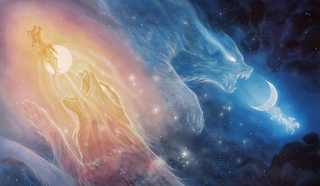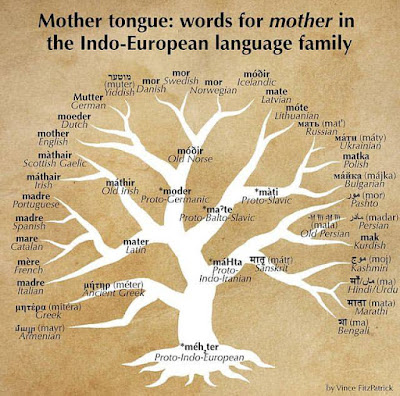Sol and Mani, An Argument Regarding Gender in the Lore
Happy Winter Nights, all. I have not been posting much lately, and I am working on some more complex posts that require more time and research, but I am not quite there yet. My day job recently changed and I am still settling into my new role. However, I do have a bunch of other ideas typed up, mostly edited, which I could stick on here whenever. (If I remembered.) The following is one of them. Hopefully, my schedule will even out a bit more soon, and I can spend the necessary time to get more complex content out as well.
If you have been following along for awhile you may have a burning question about the deities I choose to examine in this blog. Why am I focusing on male deities so much if this is supposed to be a blog about female perspective? And the answer is (clap with me) I. Don't. Care. For. Your. Judgements.
But more seriously, this blog is a female perspective. As in I am female and I am giving you my perspective. And which deities I choose to talk about come at a whim, usually right before I write about them. These are my less planned posts usually. Like this one, woke me up mid sleep cycle … and I had to begin to record it. The editing will take longer, I am sure…
In my personal practice there are so many goddesses, and I feel like on some level I am more aware of their subtle touches on the world all around me, fierce Skaði laughing during a frosty January gale, a pregnant Gerðr in a root cellar somewhere awaiting spring, like the seed sown in the fall for next year's crops. Tender Iðunn among the apple blossoms in the spring. The soft touch of Eir, as she uses hot water to clean a wound, and brews tea to break a fever. The goddesses are everywhere. They slip by with the grace of feminine that goes overlooked and unnoticed so often in our modern and patriarchal society. Their power is a sort that is undervalued, and yet so vital to our functioning.
On another level, the gender of deity is not really all that important and if I write about a male deity or female deity makes precious little difference. We cannot let ourselves as women be bound to only female deities. Nor should men be bound only to male deities. Because gender serves a different function for gods and goddesses then it does in Midgard. Gender in the pantheon is about the relationships between deities and their functions. It doesn't matter if Odin is male or female, and indeed he can be portrayed as both upon occasion. It doesn't matter if Thor dresses like a woman to get back Mjolnir and does so passibly for the Jötunn. It doesn't matter if Loki… okay, I think you see where I am going. The same can be said of the goddesses. Though they rarely try to portray themselves as men in the stories, they do act in ways that as modern heathens we would see as masculine… Freyja is at least in some sense a goddess of war. Skaði comes to the Æsir, sword drawn in vengeance. Frigga, who seems for the most part to be the most "traditionally" feminine can match Odin in contests of wit and win. For all of their seeming gentleness, you don't want to trifle with a goddess. They will knock your socks off!
Which brings me to Sunna and Mani. Or Sol and Mani. I use Sunna and Sol interchangeably in my own personal practice. Sol is the name of the sun in a surprisingly large number of cultures around the world. Sunna I prefer sometimes more poetically, because the two syllables makes it fit better with words. I am a huge word nerd, and this is going to be a word nerd type post.
Why is it that in the Lore, Sunna is female and Mani is male? If we look to the Greek and Roman traditions we see the opposite occurring. In Hellenic tradition we have a female Artemis and a male Apollo. And if we look around there are a great number of traditions where the moon is female or the night is female. The day and the sun are male. What is happening in Nordic myths? But wait, it is further complicated. Because Sol and Mani are not the same as Dagr and Nott. Nor are their genders aligned. And yet if you were going to match up Apollo it would be with Mani and Artemis with Sol, because they pull the chariots of the sun and moon. Stop.
This is always the first mistake. We as humans try to forge connections between cultures and contexts when we should not. We see patterns and want them to connect, when they were not always even meant to. (And yes, I am guilty of this too sometimes.) Take a step back. The Nordic traditions evolved separately and with minimal influence from Greek and Roman traditions. Certainly the idea of chariots itself might have been Greek or Roman, but the deities may not have been. And there has been the argument that Sunna and Mani were not originally deities at all. They were a boy and girl whose father named them too high for their stations and insulted the gods. The result was that they were cursed basically to pull the chariots of the sun and moon. And here is where it gets interesting in the Lore because they pull the sun and the moon, but they are not themselves the sun and the moon. Where this gets confusing is that the reason their naming insulted the gods was that they were named for the sun and the moon. So Sol and Mani are not the sun and the moon, but Sol and Mani are also the names of the sun and moon. Clear as mud, as usual. And in modern practice it is rarely differentiated between the actual sun and moon and those that pull the chariots, and really there isn't much purpose to differentiating beyond the argument I am currently making for the genders and natures of sun and moon in the Lore. Interestingly, the supposed curse of having to pull the sun and moon around actually raises the children to the status of deities so, in a way, it is like their fate is written that they will be as great as the names their father gave them.
Now the nature of the sun and moon and those who pull the chariots are so intertwined that they personify the same traits and so differentiating between them in practice is pretty much a waste of time. Whereas differentiating between Nott and Mani or Sol and Dagr is necessary and vital. Indeed the Lore has a lot of names for day and times of day and night and each is its own being/deity. This is a very interesting and unique feature of Nordic mythology that can be confusing if you are coming at it from other traditions.
We can assume as well that the Anglo-Saxons also believed the sun was female and the moon was male. (Don’t hurt me, if you are from an Anglo-Saxon tradition. I haven’t done a huge amount of research into this area.) We can see this evidenced even in modern English. It is always the Man in the Moon in stories, which suggests that there was always some incarnation of Mani in the culture passed down over centuries. Sunna gets obscured because the Christian influence is to erase the divinity of the feminine. But the sun is still called Sun which is clearly from the same root as Sunna. And in the Latin-based languages it is some incarnation of Sol (such as the French soleil.) So the erasure was only effective in the knowledge of the deification of the Sun, and not in the naming itself, which seems common where pagan practice was "erased" by christians and yet carried on in the practice of the common people for much longer, under the radar, before the folk tradition was largely forgotten to time.
There is still the Man in the Moon today, but what do we know of the nature of this man other than he lives in/on the moon and in some stories gets associated with the moon being made of cheese because of the holes. It doesn't sound much like Mani. It has been watered down over time as traditions were forgotten and only small portions were remembered with each generation, and new embellishments were added because….well, the story didn't make sense anymore. It didn't have much substance. Children asked questions and parents didn't know so they made something up and then that became the new story slowly over time.
And slowly over time the moon was in other contexts made to seem feminine. It is described as delicate beauty. The sun is made to be masculine and its brightness was associated with male power. The narrative shifted to enforce the patriarchy, to take power away from the feminine. The Man in the Moon persisted only as a children's bedtime story.
Further Reading:
“A Systematic Re-evaluation of the Sources of Old Norse Astronomy” by Christian Etheridge http://www.cultureandcosmos.org/pdfs/16/Etheridge_INSAPVII_Old_Norse_Astronomy.pdf
"Mani, keeper of time"
https://earthandstarryheaven.com/2015/07/24/mani-moon-god/
"Norse Gods: Máni"
http://ydalir.ca/norsegods/mani/
"Norse Gods: Sól"
http://ydalir.ca/norsegods/sol/
"Sol and Mani"
https://norse-mythology.org/sol-mani/
"Sunna’s Stead"
https://earthandstarryheaven.com/2015/07/31/sunnas-stead/
Image Source:
"Sköll and Hati" by Milivoj Ćeran
https://www.mceran-art.com/projects/yq5y3?album_id=74819



